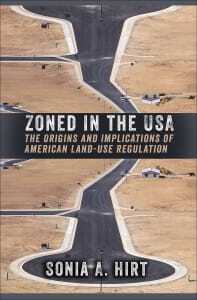Zoned in the USA: The Origins and Implications of American Land-Use Regulation
Sonia A. Hirt
Cornell University Press
512 East State Street, Ithaca, NY 14850; www.cornellpress.cornell.edu.
2014. 256 pages. Paperback, $24.95.
In this probing analysis, based largely on contrasts between the United States and Europe, planning scholar Sonia Hirt offers new and refreshing insights into zoning’s fault lines and asks why, despite recurring attempts at reform, it has yet to overcome the challenges outlined a century or more ago.
U.S. zoning is straitjacketed by an extraordinary level of land use segregation, the author contends. A tolerance for different uses within or between districts has been minimized in American municipalities. Ordinances that evolved well before World War II led to what she calls a “flat” application, whereby only residences are allowed in residential zones, commercial in commercial zones, and industry in its own zone. But in Europe, as illustrated anecdotally in the introduction, “. . . people do not mind a little store around the (housing) corner a bit. . . .” This observation was voiced in 1926 by European transplant Ernst Freund, a municipal zoning expert and one of the founders of the University of Chicago’s law school. And it remains just as valid today.
Granted, some marked successes have been achieved with mixed-use districts (planned unit developments [PUDs], performance zoning, special-use districts, etc.), culminating most recently with the advent of form-based coding, an outgrowth of the new urbanism movement. But even when these reforms have been instituted, they occur mostly as overlays or additions to, rather than replacements of, the flat model.
We have settled for a rigid system that is simultaneously more restrictive and more complex than Europe’s. Even in countries such as Germany, where codification is high,
“exclusively residential” districts permit all dwelling types and, in some instances, shops, crafts, and even hotels. Hirt references the exasperated utterance of J. Barry Cullingworth, a noted English urban planning scholar: “The American model is resistant to description, let alone explanation.”
The author, who is a professor and associate dean in the College of Architecture and Urban Studies at Virginia Polytechnic Institute and State University, correctly observes that although land uses are regulated less rigidly in much of Europe, intervention in other aspects of urban development far exceeds that seen in the United States. In the transportation realm, for instance, vast expenditures invested in upgrading train systems, streetcars, buses, and bicycle mobility put the United States to shame. Transportation debate in this country, to its discomforting discredit, remains fixated on how to replenish the Highway Trust Fund.
European political culture trusts government in the shaping of cities. Deciding what gets built and where is considerably more discretionary. Government is vested with much more flexibility in interpreting the rules (and there often are fewer rules to bother with). The American ethos, by contrast, has traditionally been characterized by a nagging distrust of government powers at all levels. Such distrust continues to assert a powerful influence on spatial rule-making.
When the author deconstructs the mythology of the American dream in its modern incarnation, her critical capacities are most focused and instructive. Hirt submits that nowhere are the distortions of U.S. zoning more pervasive than the privileged status endowed to the single-family detached dwelling, a mind-set that echoes back to William Penn, who proclaimed in 1681: “Let every house be placed . . . in the middle of its plat, so that there may be ground on each side for gardens and orchards. . . .” Ironically, Hirt’s research reveals that homeownership levels in the United States are not what we think they are. Sixty-five
percent of American housing is owner-occupied, which is less than the European Union average of 70 percent. Similarly, the percentage of low-density (ground-level) housing units is lower than in much of Europe if one discounts the distinction between detached and attached (i.e., duplexes, rowhouses, etc.). But the Jacksonville, Florida, ordinance obsessively grants primacy to single-family detached by parsing it into 11 different zones. That represents one-third of its zoning types.
How paradoxical, she concludes, that a culture so resistant to government authority is willing to subject itself to such prescriptive municipal rules in order to preserve the sacred homestead. And she is wary that so many other expectations promulgated during the formative years of modern zoning remain unresolved. These include such claims as greater traffic safety, public health, and air quality. The fact that such challenges are still with us (but in a much different form) renders early aspirations as “hopelessly naïve and simplistic.”
Hirt offers no prescriptions or remedies; that discussion is left to others. The burden of American zoning is not the only reason that U.S. cities fail to measure up to their European peers, but it continues to be a major contributing factor.





